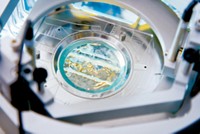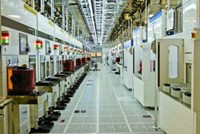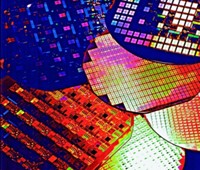Advertisement
Grab your lab coat. Let's get started
Welcome!
Welcome!
Create an account below to get 6 C&EN articles per month, receive newsletters and more - all free.
It seems this is your first time logging in online. Please enter the following information to continue.
As an ACS member you automatically get access to this site. All we need is few more details to create your reading experience.
Not you? Sign in with a different account.
Not you? Sign in with a different account.
ERROR 1
ERROR 1
ERROR 2
ERROR 2
ERROR 2
ERROR 2
ERROR 2
Password and Confirm password must match.
If you have an ACS member number, please enter it here so we can link this account to your membership. (optional)
ERROR 2
ACS values your privacy. By submitting your information, you are gaining access to C&EN and subscribing to our weekly newsletter. We use the information you provide to make your reading experience better, and we will never sell your data to third party members.
Materials
Electronic Materials Tough It Out
Makers of electronic chemicals remain committed to innovation despite hard times
by Jean-François Tremblay
July 13, 2009
| A version of this story appeared in
Volume 87, Issue 28

Seventeen years in the electronic materials industry have taught Corning F. Painter this lesson: An electronic materials supplier that cuts down on R&D commits corporate suicide. "One way to drop out is to discontinue research," says the Taipei-based head of global electronics at Air Products & Chemicals. "Two to three years later, you're not positioned for what comes up."
Like those in other business sectors, companies supplying materials to electronic components manufacturers have had an exceptionally difficult time in the past eight months. Because of the steep decline in demand for electronic chemicals, producers are struggling to maintain profitability by dramatically cutting production. Yet amid the global economic downturn, the pace of new product development hasn't slowed, with electronic materials suppliers preserving, and even strengthening, their R&D capabilities.
For example, Nobu Koshiba, president of Japan's JSR Corp., can't conceive of drastically cutting back on R&D spending, even though the company's sales of electronic materials will likely shrink considerably. "I need to readjust our fixed costs to reflect the reduced size of our sales," he says. "So I will cut back into some of our excess production capacity, but I won't sacrifice our future by cutting R&D." JSR is, in fact, expanding its materials R&D programs into new markets such as lithium capacitors, where the company has no sales yet, Koshiba points out.
The magnitude of the drop in business over the past six months is stunning. At JSR, which provides dielectrics, photoresists, optical films, and other materials to both the semiconductor and the flat-panel-display industries, business in the first three months of 2009 was down about 40% from a year ago, Koshiba says.
For the whole of 2009, Koshiba foresees that demand for electronic materials could be down 30% compared with 2007, which was an exceptionally good year. Putting things into a historical context, Koshiba says the current downturn is about as bad as what the electronics industry went through in 2001 after the burst of the dot-com bubble.
"Until August last year, business was so strong we didn't know where to get our raw materials," says Karl-Rudolf Kurtz, a group vice president who heads BASF's global electronic materials business. BASF's range of electronic materials includes pure chemicals and chemical planarization slurries used in the semiconductor industry, display materials such as optical films, and chemicals used in solar cell manufacturing. "Then suddenly business almost stopped in October," he recalls. One of the few things Kurtz could do when the crisis started was cut down production in order not to accumulate excess inventory.
If it's any consolation, companies have better information systems to manage production and inventories during this downturn than they did in 2001. At Air Products, for example, once Painter realized last autumn that demand had fallen off a cliff, he asked for a list of products in Air Products' inventory that have a limited shelf life and received it in one day. "In the past, this would have taken maybe a month of manual labor to track down," he says. "We have better tools to manage the downturn."
Most electronic chemicals go into three major markets: semiconductors, display panels, and solar energy cells. Each business has long had its own dynamic, which has held through the economic downturn.

The semiconductor industry is the most sophisticated segment, requiring the most advanced materials. It's also the one in the most trouble. A recovery to the level of sales in 2007 could take as long as five years, JSR's Koshiba says. Yet he acknowledges that his dire recovery scenario could be too pessimistic. Historically, the personal computer market has been the chief barometer for the semiconductor industry, he explains. But today, integrated circuits are in a wide range of applications, including cars and telephones. "Semiconductors could become less cyclical," he says.
In the flat-panel-display segment, first-quarter demand for televisions, computer screens, and mobile phones was so weak that producers had to cut capacity utilization of manufacturing facilities to only 60%, says David Hsieh, vice president for Greater China at the market consulting firm DisplaySearch. Since April, however, demand has strengthened to last year's level. "For the remainder of this year, we are sort of optimistic for panel demand, as well as for the materials suppliers," he says.

Among these suppliers is Merck KGaA, the world's leading producer of liquid crystals for liquid-crystal displays (LCDs), the most common screen. After a sharp drop late last year and early in 2009, sales of liquid crystals are now slowly climbing back to the level they were at in the first half of 2008, says Roman Maisch, Merck's vice president of liquid-crystal marketing and sales. Sales in euros or dollars remain down somewhat, however, because of reduced pricing.
Moreover, much of the demand is for "standard mixtures" of liquid crystals used to build 32-inch LCDs, Maisch says. The display industry had believed that consumers were eager to buy the largest possible displays, but Maisch notes that they tend to be satisfied with medium-sized screens. Consumers in China, where demand is particularly robust, mostly buy 32-inch LCD TVs.
China has been key to the recovery of the display segment in the past few months. Strong demand there is due to an economic stimulus package that is boosting consumer demand for television sets. In June, Air Liquide said it would spend $35 million to build air separation plants in southwest China that will supply new facilities producing LCDs for televisions. The French firm noted that Chinese production capacity for LCD TVs is increasing at nearly 30% annually.
In contrast to the recession-induced slump in demand for display and semiconductor materials, demand for solar materials such as polysilicon, protective films, and specialty gases has remained strong through the economic downturn. This is particularly true in Asia where, according to BASF's Kurtz, most solar energy projects that have been announced are still going ahead.

The buoyant solar energy market is still not large enough, however, to rescue electronic materials producers, Painter says. Despite its rapid growth, the market for solar energy materials remains smaller than that for semiconductor or display materials. The standout material is polysilicon, which is now used more by the solar energy industry than by semiconductor makers. Moreover, because the materials used to generate solar energy can be less pure than those required by the semiconductor and display industries, profit margins are lower, Kurtz says.
Even as demand from these three markets stalls, the electronics industry continues to launch an increasing variety of devices that require a broader range of materials than ever. In fact, today's iPhones, BlackBerry Smartphones, and MP3 players can boast as much computing firepower as a two-year-old laptop or PC. The next-generation models are going to be even more powerful.
"The ecosystem of microelectronics has expanded," says Geoff Irvine, vice president of business development at SAFC Hitech, the performance materials arm of Sigma-Aldrich. The chips that go into mobile phones are different from those used to make desktop computers, he explains. At the same time, old chip designs now remain in production long after newer and higher performing ones have entered the marketplace. Materials suppliers therefore must support multiple product generations.
Despite the downturn, Irvine says, SAFC's customers have intensified their R&D into the numerous types of chips that manufacturers of consumer goods demand. One of the major trends, he notes, is the rise of electronic devices that are smaller, consume less power, and emit less heat. These new requirements affect manufacturing processes and the types of materials being used. "We're seeing an acceleration of R&D," he says, and SAFC has responded by hiring more researchers of its own.
In the electronics industry, SAFC is a supplier of semiconductor materials with particular expertise in design and supply of materials used for thin film deposition processes. The company also participates in the solar industry, where it serves manufacturers of thin film and solar cells.
The same intensifying trend in chip R&D is supporting demand for certain chemicals from Air Products. Chip manufacturers are constantly trying to cram more memory onto one piece of silicon by making circuitry smaller, Painter says. Air Products is experiencing good demand for its LTN and LTO lines of silicon nitride and silicon oxide precursor molecules, which can be deposited at lower temperatures, thus reducing the risk of damaging fragile circuits during the manufacturing process. Demand for these product lines has been good despite the downturn, according to Painter. "We've raced to ramp up production to meet global demand, even in the downturn," he says.
Electronic materials suppliers always endeavor to support semiconductor companies' efforts to shrink chip circuitry. Kurtz says BASF recently launched a new type of chemical planarization slurry, used to polish chips during manufacture. Polishing can damage chips, and BASF's new silica-free "adaptive organic" slurries contain "smart" particles designed to deliver just the right amount of chemical components to the wafer, the company says. This reduces the danger posed by excessive polishing.
It is also becoming particularly hard to develop circuit wire insulating materials that meet the semiconductor industry's needs. These materials, known as low-k dielectrics, have a small dielectric constant compared with silicon dioxide, the traditional insulator. "We should really use something like air, but it's not that easy to handle," Kurtz says. It may seem odd, but according to BASF, air is the "ultimate" low-k material, as long as it can be controlled effectively.
Air Products has found a way to handle air, according to Painter, with a dielectric system it calls pDEMS, for porous diethoxymethylsilane. It allows chip makers to apply a low-k film featuring pores filled with air. Some semiconductor plants producing advanced generations of chips are using the material, Painter says.
In February, JSR announced a research collaboration with IBM to develop new materials for the next generation of microcircuits. For example, the companies are seeking a material that combines the functions of a low-k dielectric and a photoresist—used to imprint circuitry on semiconductors by means of photolithography. Combining the two functions into a single material will reduce waste and simplify manufacturing, the partners say.
Innovation continues in display technology as well, because even though economically constrained consumers are sticking to the basics, such as modest-sized TV sets, others still look for high-end goods. Merck's sales head Maisch says it's been surprising to see how quickly manufacturers of flat displays have adopted Merck's new liquid-crystal technology, dubbed Polymer Stabilized-Vertical Alignment.
Displays based on the new materials promise high contrast and fast switching, properties that reduce the amount of power required for backlighting. The liquid-crystal materials can be used in television sets, mobile phones, and portable gaming devices. "There is strong demand for our latest technology," which Merck has been developing in close collaboration with customers since 2006, Maisch says.
Reducing the amount of power that an LCD consumes is a major goal among flat-panel-display manufacturers. One approach uses a light-emitting diode (LED) as the backlight source instead of standard cold-cathode fluorescent light (CCFL), DisplaySearch's Hsieh says. LED backlights are "the most influential technical change under way now" at panel manufacturers, he says.
The switch to LED backlighting involves a whole range of new materials, Hsieh says, in particular because LED light is not as strong as CCFL and LED lighting works only with the help of brightness enhancement filters. Because only a handful of materials manufacturers have the know-how to make brightness enhancement films, Hsieh says, the panel industry has been experiencing shortages in the past six months.
At Fujifilm, meanwhile, business managers are thinking beyond simple improvements in backlighting. Earlier this year, the company said it had developed two new films that could lead to breakthroughs in flexible displays, electronic paper, solar cells, and flat light sources.
Traditionally a producer of photographic films, Fujifilm has recently emerged as a world leader in the development of films used in LCDs. It manufactures films that widen display-viewing angles. And it is the world's largest producer of cellulose triacetate films used in LCD polarizers. In the fiscal year that ended March 31, however, the company suffered a sharp drop in demand for its display films as a result of the global recession.
Advertisement
One of Fujifilm's new display films has extremely high moisture barrier properties. Covering a display panel with a strong barrier against air and moisture is essential to maintaining device performance and ensuring durability. So far, glass is the only transparent material with the necessary properties, says Katsuo Nakadai, senior engineering manager for Fujifilm's industrial products division.
"No such material has been available in the past, therefore manufacturers have been developing devices on the assumption that such a material would not exist," Nakadai says. How much of a blockbuster the new material will be for Fujifilm remains unclear because the company's customers are still only testing samples. But Nakadai expects the film will find wide use among producers of organic LEDs, electronic paper, and even flexible solar cells that could be fitted on the body of a car.
Fujifilm's customers are also assessing the other new film, branded Exclear. Making use of technology Fujifilm originally developed for black-and-white photography, the transparent film is made of polyethylene terephthalate coated with a light-sensitive silver halide. Intended as a conductive material for touch-panel displays, the film can replace indium tin oxide, which cracks and breaks over time.
"We're hoping for 100% adoption by customers," Nakadai says. "We don't think that adoption will slow during the downturn because the film is the material that panel makers had hoped for." Because of its properties, Exclear can also be used in flat light sources. By 2013, the market for the film could be worth more $400 million, Fujifilm predicts.
It took Fujifilm several years to develop the new films, a length of time that is not unusual in the electronic materials industry. From time to time, however, material makers come up with innovation much faster.
For example, as a direct result of the global economic downturn, Air Products came up with a xenon-recovery system for use inside semiconductor plants, where the noble gas is used in a number of processes. According to Painter, the global supply of xenon has tightened sharply since the economic downturn began, thereby making recycling the rare gas imperative.
Xenon is extracted from air by air separation plants designed mainly to supply oxygen, nitrogen, and argon, Painter explains. Because it represents just a small fraction of the air, xenon can be economically captured only at large separation plants that are typically set up at steel mills, he says. And when steel production went down with the rest of the economy, xenon availability fell as well.
Air Products' Xecovery system allows semiconductor fabricators to recycle a portion of the xenon they use. "The industry is looking for cost control, and the recycling of xenon is a great cost control," Painter says. "It's not like you can go out and make more xenon." Semiconductor producers are now testing the technology.
That the economic downturn spurred innovation among makers of electronic materials is par for the course in an industry where innovation is a way of life. Among managers of electronic materials companies, there is probably no one who believes that cutting R&D is a good way to raise profits. In fact it's quite the opposite. "Only new products, new materials," BASF's Kurtz says, "will get us out."






Join the conversation
Contact the reporter
Submit a Letter to the Editor for publication
Engage with us on Twitter